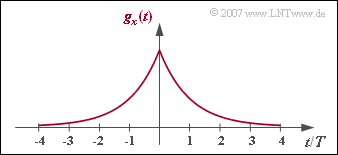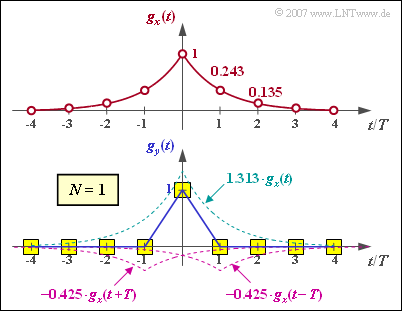Difference between revisions of "Aufgaben:Exercise 3.6Z:Optimum Nyquist Equalizer for Exponential Pulse"
From LNTwww
| (3 intermediate revisions by the same user not shown) | |||
| Line 2: | Line 2: | ||
{{quiz-Header|Buchseite=Digital_Signal_Transmission/Linear_Nyquist_Equalization}} | {{quiz-Header|Buchseite=Digital_Signal_Transmission/Linear_Nyquist_Equalization}} | ||
| − | [[File:P_ID1434__Dig_Z_3_6.png|right|frame|Two-sided exponential pulse]] | + | [[File:P_ID1434__Dig_Z_3_6.png|right|frame|Two-sided exponential input pulse]] |
| − | As in [[Aufgaben:Exercise_3.6:_Transversal_Filter_of_the_Optimal_Nyquist_Equalizer| | + | As in [[Aufgaben:Exercise_3.6:_Transversal_Filter_of_the_Optimal_Nyquist_Equalizer|Exercise 3.6]] we consider again the optimal Nyquist equalizer. |
| + | *The input pulse $g_x(t)$ is a two-sided exponential function: | ||
:$$g_x(t) = {\rm e }^{ - |t|/T}\hspace{0.05cm}.$$ | :$$g_x(t) = {\rm e }^{ - |t|/T}\hspace{0.05cm}.$$ | ||
| − | |||
*Through a transversal filter of $N$–th order with the impulse response | *Through a transversal filter of $N$–th order with the impulse response | ||
:$$h_{\rm TF}(t) = \sum_{\lambda = -N}^{+N} k_\lambda \cdot \delta(t - \lambda \cdot T)$$ | :$$h_{\rm TF}(t) = \sum_{\lambda = -N}^{+N} k_\lambda \cdot \delta(t - \lambda \cdot T)$$ | ||
| − | :it is | + | :it is possible that the output pulse $g_y(t)$ has zero crossings at $t/T = ±1, \ \text{...} \ , \ t/T = ±N$, <br>while $g_y(t = 0) = 1$. |
| − | *However, in the general case, the precursors and trailers with $| \nu | > N$ | + | |
| − | + | *However, in the general case, the precursors and trailers with $| \nu | > N$ lead to intersymbol interference. | |
| − | |||
| − | + | Note: The exercise belongs to the chapter [[Digital_Signal_Transmission/Linear_Nyquist_Equalization|"Linear Nyquist Equalization"]]. | |
| − | |||
| Line 36: | Line 34: | ||
$k_1 \ = \ $ { -0.43775--0.41225 } | $k_1 \ = \ $ { -0.43775--0.41225 } | ||
| − | {Calculate the output values $g_2 = g_{ | + | {Calculate the output values $g_2 = g_{y}(t = 2T)$ and $g_3 = g_{y}(t = 3T)$. |
|type="{}"} | |type="{}"} | ||
$g_2 \ = \ $ { 0. } | $g_2 \ = \ $ { 0. } | ||
| Line 42: | Line 40: | ||
{Which of the following statements is true? | {Which of the following statements is true? | ||
| − | |type=" | + | |type="()"} |
+ For the given input pulse $g_x(t)$, no improvement is possible with a second-order transversal filter. | + For the given input pulse $g_x(t)$, no improvement is possible with a second-order transversal filter. | ||
- The first statement is independent of the input pulse $g_x(t)$. | - The first statement is independent of the input pulse $g_x(t)$. | ||
| − | - For the given input pulse, a further improvement is obtained with an "infinite" transversal filter. | + | - For the given input pulse, a further improvement is obtained with an "infinite" transversal filter. |
</quiz> | </quiz> | ||
===Solution=== | ===Solution=== | ||
{{ML-Kopf}} | {{ML-Kopf}} | ||
| − | '''(1)''' The five first samples of the input pulse at distance $T$ are: | + | '''(1)''' The five first samples of the input pulse at distance $T$ are: |
:$$g_x(0)\hspace{0.25cm}\underline{ = 1},\hspace{0.2cm}g_x(1) \hspace{0.25cm}\underline{= 0.368},\hspace{0.25cm}g_x(2) \hspace{0.25cm}\underline{= | :$$g_x(0)\hspace{0.25cm}\underline{ = 1},\hspace{0.2cm}g_x(1) \hspace{0.25cm}\underline{= 0.368},\hspace{0.25cm}g_x(2) \hspace{0.25cm}\underline{= | ||
0.135},\hspace{0.2cm}g_x(3) = 0.050,\hspace{0.2cm}g_x(4) {= 0.018} | 0.135},\hspace{0.2cm}g_x(3) = 0.050,\hspace{0.2cm}g_x(4) {= 0.018} | ||
| Line 56: | Line 54: | ||
| − | '''(2)''' According to | + | '''(2)''' According to [[Aufgaben:Exercise_3.6:_Transversal_Filter_of_the_Optimal_Nyquist_Equalizer|"solution to Exercise 3.6"]], we arrive at the following system of equations: |
:$$2t = T \hspace{-0.1cm}:\hspace{0.2cm}g_1 \hspace{-0.2cm} \ = \ \hspace{-0.2cm} k_0 \cdot g_x(1) +k_1 \cdot | :$$2t = T \hspace{-0.1cm}:\hspace{0.2cm}g_1 \hspace{-0.2cm} \ = \ \hspace{-0.2cm} k_0 \cdot g_x(1) +k_1 \cdot | ||
[g_x(0)+g_x(2)]= 0\hspace{0.3cm}\Rightarrow \hspace{0.3cm} | [g_x(0)+g_x(2)]= 0\hspace{0.3cm}\Rightarrow \hspace{0.3cm} | ||
| Line 70: | Line 68: | ||
| − | '''(3)''' For time $t = 2T$ holds: | + | [[File:P_ID1440__Dig_Z_3_6_c.png|right|frame|Input pulse (top), output pulse for $N = 1$ (bottom)]] |
| − | :$$g_2 \ = \ k_0 \cdot g_x(2) +k_1 \cdot [g_x(1)+g_x(3)]= \ 1.313 \cdot 0.050 -0.425 \cdot [0.135+0.018]\hspace{0.15cm}\underline {\approx 0} | + | '''(3)''' For time $t = 2T$ holds: |
| + | :$$g_2 \ = \ k_0 \cdot g_x(2) +k_1 \cdot [g_x(1)+g_x(3)]$$ | ||
| + | :$$\Rightarrow\hspace{0.3cm} g_2 \ = \ 1.313 \cdot 0.050 -0.425 \cdot [0.135+0.018]\hspace{0.15cm}\underline {\approx 0} | ||
\hspace{0.05cm}.$$ | \hspace{0.05cm}.$$ | ||
| − | *Similarly, the output pulse at time $t = 3T$ is also zero: | + | *Similarly, the output pulse at time $t = 3T$ is also zero: |
| − | :$$g_3 \ = \ k_0 \cdot g_x(3) +k_1 \cdot [g_x(2)+g_x(4) | + | :$$g_3 \ = \ k_0 \cdot g_x(3) +k_1 \cdot [g_x(2)+g_x(4)$$ |
| + | :$$\Rightarrow\hspace{0.3cm}g_3 \ = \ 1.313 \cdot 0.135 -0.425 \cdot [0.368+0.050]\hspace{0.15cm}\underline {\approx 0} | ||
\hspace{0.05cm}.$$ | \hspace{0.05cm}.$$ | ||
| + | *The figure shows that '''for this exponentially decaying pulse, the first-order transversal filter provides complete equalization'''. | ||
| + | |||
| + | *Outside the interval $-T < t < T$, $g_y(t)$ is identically zero. | ||
| + | |||
| + | *Inside it results in a triangular shape. | ||
| − | |||
| − | * | + | '''(4)''' Only the <u>first statement</u> is correct: |
| − | + | *Since already with a first-order delay filter all precursors and trailers are compensated, also with a second-order filter and also for $N → ∞$ no further improvements result. | |
| + | *However, '''this result applies exclusively to the (bilaterally) exponentially decaying input pulse'''. | ||
| − | + | *For almost any other pulse shape, the larger $N$ is, the better the result. | |
| − | |||
| − | |||
| − | *For almost any other pulse shape, the larger $N$ is, the better the result. | ||
{{ML-Fuß}} | {{ML-Fuß}} | ||
Latest revision as of 17:01, 22 June 2022
As in Exercise 3.6 we consider again the optimal Nyquist equalizer.
- The input pulse $g_x(t)$ is a two-sided exponential function:
- $$g_x(t) = {\rm e }^{ - |t|/T}\hspace{0.05cm}.$$
- Through a transversal filter of $N$–th order with the impulse response
- $$h_{\rm TF}(t) = \sum_{\lambda = -N}^{+N} k_\lambda \cdot \delta(t - \lambda \cdot T)$$
- it is possible that the output pulse $g_y(t)$ has zero crossings at $t/T = ±1, \ \text{...} \ , \ t/T = ±N$,
while $g_y(t = 0) = 1$.
- However, in the general case, the precursors and trailers with $| \nu | > N$ lead to intersymbol interference.
Note: The exercise belongs to the chapter "Linear Nyquist Equalization".
Questions
Solution
(1) The five first samples of the input pulse at distance $T$ are:
- $$g_x(0)\hspace{0.25cm}\underline{ = 1},\hspace{0.2cm}g_x(1) \hspace{0.25cm}\underline{= 0.368},\hspace{0.25cm}g_x(2) \hspace{0.25cm}\underline{= 0.135},\hspace{0.2cm}g_x(3) = 0.050,\hspace{0.2cm}g_x(4) {= 0.018} \hspace{0.05cm}.$$
(2) According to "solution to Exercise 3.6", we arrive at the following system of equations:
- $$2t = T \hspace{-0.1cm}:\hspace{0.2cm}g_1 \hspace{-0.2cm} \ = \ \hspace{-0.2cm} k_0 \cdot g_x(1) +k_1 \cdot [g_x(0)+g_x(2)]= 0\hspace{0.3cm}\Rightarrow \hspace{0.3cm} \frac{k_1}{k_0} = - \frac{g_x(1)}{g_x(0)+g_x(2)} \hspace{0.05cm},$$
- $$t = 0 \hspace{-0.1cm}:\hspace{0.2cm}g_0 \hspace{-0.2cm} \ = \ \hspace{-0.2cm} k_0 \cdot g_x(0) + k_1 \cdot 2 \cdot g_x(1) = 1\hspace{0.3cm}\Rightarrow \hspace{0.3cm} k_1 = \frac{1-k_0}{0.736} \hspace{0.05cm}.$$
- This leads to the result:
- $$k_0 - 0.324 \cdot 0.736 \cdot k_0 = 1 \hspace{0.3cm}\Rightarrow \hspace{0.3cm} k_0 \hspace{0.15cm}\underline {= 1.313}, \hspace{0.2cm}k_1\hspace{0.15cm}\underline { = -0.425} \hspace{0.05cm}.$$
(3) For time $t = 2T$ holds:
- $$g_2 \ = \ k_0 \cdot g_x(2) +k_1 \cdot [g_x(1)+g_x(3)]$$
- $$\Rightarrow\hspace{0.3cm} g_2 \ = \ 1.313 \cdot 0.050 -0.425 \cdot [0.135+0.018]\hspace{0.15cm}\underline {\approx 0} \hspace{0.05cm}.$$
- Similarly, the output pulse at time $t = 3T$ is also zero:
- $$g_3 \ = \ k_0 \cdot g_x(3) +k_1 \cdot [g_x(2)+g_x(4)$$
- $$\Rightarrow\hspace{0.3cm}g_3 \ = \ 1.313 \cdot 0.135 -0.425 \cdot [0.368+0.050]\hspace{0.15cm}\underline {\approx 0} \hspace{0.05cm}.$$
- The figure shows that for this exponentially decaying pulse, the first-order transversal filter provides complete equalization.
- Outside the interval $-T < t < T$, $g_y(t)$ is identically zero.
- Inside it results in a triangular shape.
(4) Only the first statement is correct:
- Since already with a first-order delay filter all precursors and trailers are compensated, also with a second-order filter and also for $N → ∞$ no further improvements result.
- However, this result applies exclusively to the (bilaterally) exponentially decaying input pulse.
- For almost any other pulse shape, the larger $N$ is, the better the result.

